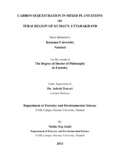Please use this identifier to cite or link to this item:
http://archive.nnl.gov.np:8080/handle/123456789/169Full metadata record
| DC Field | Value | Language |
|---|---|---|
| dc.contributor.author | Joshi, Nabin Raj | |
| dc.date.accessioned | 2019-03-24T06:26:27Z | |
| dc.date.accessioned | 2020-08-21T07:26:11Z | - |
| dc.date.available | 2019-03-24T06:26:27Z | |
| dc.date.available | 2020-08-21T07:26:11Z | - |
| dc.date.issued | 2019-03-24 | |
| dc.identifier.uri | http://103.69.125.248:8080/xmlui/handle/123456789/169 | - |
| dc.description.abstract | The Indian Himalaya is a vast mountain system with a geographical area of about 5, 91,000 sq. km representing 18% area of the country and is an important part of the global system. The Himalayan region is one of the most dynamic and complex mountain ranges in the world due to tectonic activity and is very vulnerable due to global climate change. Global change, whether generated by climate, land use change, biological invasion, global economic forces, will certainly affect the relationships that are present in the land and economics of the Himalayan region. Uncertainties and potential impacts of the rate and magnitude of climate change prevail, but there is no question that it is gradually and powerfully changing the ecological and socioeconomic landscape of the region. The fact that India is recognized as one of the twelve mega biodiversity regions of the world is mainly due to the Himalaya region. | en_US |
| dc.language.iso | en | en_US |
| dc.subject | biodiversity | en_US |
| dc.subject | climate change | en_US |
| dc.title | “CARBON SEQUESTRATION IN MIXED PLANTATIONS OF TERAI REGION OF KUMAUN, UTTARAKHAND | en_US |
| dc.type | Thesis | en_US |
| Appears in Collections: | 300 Social sciences | |
Files in This Item:
| File | Description | Size | Format | |
|---|---|---|---|---|
| Thises Nabin Raj Joshi_ final_2013.pdf | 22.28 MB | Adobe PDF |  View/Open |
Items in DSpace are protected by copyright, with all rights reserved, unless otherwise indicated.